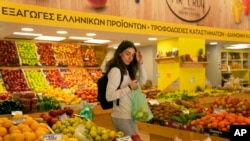The impact of Russia's invasion of Ukraine — a country long known as the "breadbasket of Europe" because of the prodigious amounts of wheat, corn and other cereal grains that it produces — will extend far beyond Europe, wreaking havoc on global food supplies, experts from aid agencies say.
Ukraine produces 16% of the world's corn, and Ukraine and Russia combined produce 29% of the wheat sold on world markets. Much of what they export goes to Africa, the Middle East and South Asia, and with virtually no cargo moving out of either county's Black Sea ports, prices for the staple foods are spiking. Still unknown is whether an enduring war in Ukraine will damage this year's harvest or prevent the sowing of crops for the next growing season.
Preexisting food crisis
Globally, food prices were already at a 10-year high before Russia invaded Ukraine, according to the United Nations World Food Program. Since Feb. 25, the day after Russia launched its full-scale invasion, wheat futures have risen by as much as 40% and corn futures by as much as 16%.
Because the war is already disrupting global fuel supplies — a problem that will worsen dramatically if sanctions on Russia are expanded to cover its energy exports — higher transportation costs are contributing to the rise in prices.
"We're already facing a hunger crisis globally that we haven't seen, at least this century," Jordan Teague, an interim director for the charity group Bread for the World, told VOA.
"This is yet one more example of conflict generating hunger around the world, and the world just can't sustain this," said Steve Taravella, a senior spokesperson for the U.N. WFP. "We've got Yemen, we've got South Sudan, we've got Afghanistan. A significant amount of WFP resources is devoted to addressing hunger caused by man-made conflicts around the world, and this is just one more on top of that," he told VOA.
Areas of concern
Teague said that while multiple countries are facing serious food shortages, her group is particularly concerned about several in the Middle East and East Africa, all of which rely on imports from Ukraine and Russia.
In Yemen, she said, tens of thousands of people are experiencing famine and another 16 million are facing a food crisis and in danger of famine. Even before the current crisis, she said, price inflation, currency depreciation and depleted foreign reserves had left Yemen struggling to import food.
Similarly, Lebanon, which, Teague said, imports about 60% of its wheat from Ukraine, is having difficulty buying enough food. More than one-third of the population there is already food insecure, and that doesn't count the thousands of refugees displaced by the conflict in Syria, who are largely dependent on humanitarian assistance.
Ethiopia, currently locked in a brutal civil war, also faces a hunger crisis that the Ukraine conflict is likely to make worse. The country relies on imports for about 25% of its wheat, Teague said.
UN to continue aid
Ukraine is the WFP's largest supplier of wheat and split peas, two key staples it uses to feed the hungry, Taravella said. However, while the shortages caused by the Ukraine conflict will increasingly strain his organization's ability to deliver food to the more than 135 million people it serves around the world, the WFP's programs will continue to operate.
"Because we have supply chain expertise and we have, for years, developed strategies for making sure we can get commodities into hard-to-reach countries in difficult times, we have other sources," he said. "I'm not concerned that WFP won't be able to find wheat or split peas or other things that we rely on Ukraine for. What we're concerned about is what we and others will have to pay for them, because prices are going to go up."
The agency might be forced to reduce the per-person ration of food it provides, he said. "It will cost us more, which will mean we may have to cut rations. Those are very real implications," he said.
Ukraine food situation shaky
Within Ukraine, the fighting appears not to not have cut off food supplies, but media reports indicate that stores are finding it increasingly difficult to remain open.
Fozzy Group, the country's largest supermarket chain, continued to operate most of its stores this week, even in cities such as Kharkiv and Kyiv, which are facing direct attacks from Russian troops. Stores have had to close on an ad hoc basis, sometimes with little notice, when managers determine that the risks of remaining open are too great.
According to the news agency Interfax-Ukraine, a group of retail outlets and the country's Ministry of Digital Transformation have created an online map that indicates whether a grocery store is open and its hours of operation.









